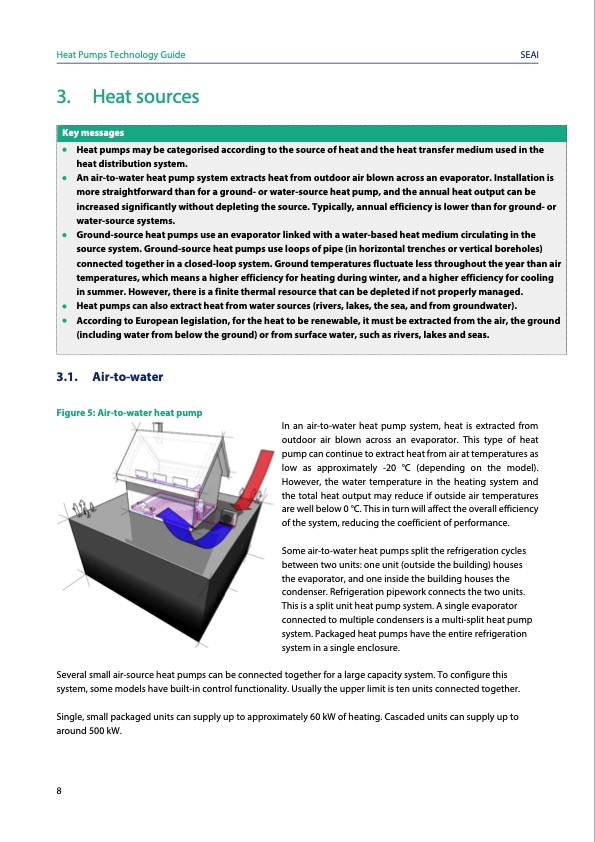
PDF Publication Title:
Text from PDF Page: 012
Heat Pumps Technology Guide SEAI 3. Heat sources Key messages • Heat pumps may be categorised according to the source of heat and the heat transfer medium used in the heat distribution system. • An air-to-water heat pump system extracts heat from outdoor air blown across an evaporator. Installation is more straightforward than for a ground- or water-source heat pump, and the annual heat output can be increased significantly without depleting the source. Typically, annual efficiency is lower than for ground- or water-source systems. • Ground-source heat pumps use an evaporator linked with a water-based heat medium circulating in the source system. Ground-source heat pumps use loops of pipe (in horizontal trenches or vertical boreholes) connected together in a closed-loop system. Ground temperatures fluctuate less throughout the year than air temperatures, which means a higher efficiency for heating during winter, and a higher efficiency for cooling in summer. However, there is a finite thermal resource that can be depleted if not properly managed. • Heat pumps can also extract heat from water sources (rivers, lakes, the sea, and from groundwater). • According to European legislation, for the heat to be renewable, it must be extracted from the air, the ground (including water from below the ground) or from surface water, such as rivers, lakes and seas. 3.1. Air-to-water Figure 5: Air-to-water heat pump In an air-to-water heat pump system, heat is extracted from outdoor air blown across an evaporator. This type of heat pump can continue to extract heat from air at temperatures as low as approximately -20 °C (depending on the model). However, the water temperature in the heating system and the total heat output may reduce if outside air temperatures are well below 0 °C. This in turn will affect the overall efficiency of the system, reducing the coefficient of performance. Some air-to-water heat pumps split the refrigeration cycles between two units: one unit (outside the building) houses the evaporator, and one inside the building houses the condenser. Refrigeration pipework connects the two units. This is a split unit heat pump system. A single evaporator connected to multiple condensers is a multi-split heat pump system. Packaged heat pumps have the entire refrigeration system in a single enclosure. Several small air-source heat pumps can be connected together for a large capacity system. To configure this system, some models have built-in control functionality. Usually the upper limit is ten units connected together. Single, small packaged units can supply up to approximately 60 kW of heating. Cascaded units can supply up to around 500 kW. 8PDF Image | Heat Pumps Technology Guide

PDF Search Title:
Heat Pumps Technology GuideOriginal File Name Searched:
Heat-Pump-Technology-Guide.pdfDIY PDF Search: Google It | Yahoo | Bing
CO2 Organic Rankine Cycle Experimenter Platform The supercritical CO2 phase change system is both a heat pump and organic rankine cycle which can be used for those purposes and as a supercritical extractor for advanced subcritical and supercritical extraction technology. Uses include producing nanoparticles, precious metal CO2 extraction, lithium battery recycling, and other applications... More Info
Heat Pumps CO2 ORC Heat Pump System Platform More Info
| CONTACT TEL: 608-238-6001 Email: greg@infinityturbine.com | RSS | AMP |